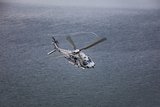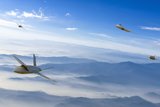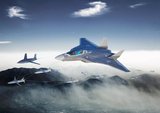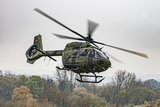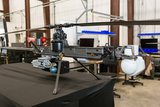Australian firm selected for US hypersonic test vehicle requirement
The Dart AE selected for the DIU's HyCAT programme is due to fly in early 2024. (Image: Hypersonix Launch Systems)
Australia's Hypersonix Launch Systems has been selected to provide hypersonic vehicles to the US Defense Innovation Unit (DIU) for testing.
The DIU issued a competitive solicitation as part of its Hypersonic and High-Cadence Airborne Testing Capabilities (HyCAT1) programme. There were 63 respondents.
According to the company, its selection demonstrates an increased US DoD willingness to source commercial technologies from allied countries.
Related Articles
Hypersonic testing 'vital' as US pushes for 2023 missile capability
BAE and Innovaero debut Strix, Australia’s first domestic armed VTOL UAS
How the Pentagon will use private capital to fund critical capabilities
The September 2022 DIU HyCAT solicitation sought vehicles for testing hypersonic platforms and components; sensors for detecting and tracking; and systems for communications, navigation, guidance and control.
Such vehicles should be capable of operating in a 'representative environment' and maintain speeds above Mach 5 in a manoeuvrable/non-ballistic flight profile for least a three-minute duration.
Hypersonix submitted its Dart AE (Additive Engineering) design, which makes use of 3D printing and is powered by a hydrogen-fuelled scramjet, It can fly non-ballistic flight patterns at speeds of Mach 5-7 and over 1,000km (400s flight time).
Dart AE has a payload bay holding up to 9kg and first flight is scheduled for early 2024.
'Our vehicles are capable of non-ballistic flight patterns to at least Mach 7, which exceeds the HyCAT1 specification,' David Waterhouse, MD of Hypersonix Launch Systems, said.
'Our longer-term focus is to capture a slice of the emerging multi-billion-dollar commercial market for deployment of small satellites, but clearly Australia’s strategic defence allies see immediate potential in our technology.'
Hypersonix and Kratos signed an agreement in January 2022 to develop and launch DART AE. The University of Southern Queensland, LSM Advanced Composites and Roman Engineering are also involved in the project.
On 29 March 2022, the Australian government awarded an A$2.95 million ($2.21 million) Cooperative Research Centers Project ) grant to continue DART AE's development.
Related Equipment in Defence Insight
More from Air Warfare
-
![German Navy in “ramp-up” phase as it welcomes first NH90 Sea Tiger delivery]()
German Navy in “ramp-up” phase as it welcomes first NH90 Sea Tiger delivery
With all 31 aircraft set to be delivered by 2030, the helicopters will gradually replace the ageing Sea Lynx fleet which are due to be retired in 2026.
-
![The future is here: Sixth-gen air dominance]()
The future is here: Sixth-gen air dominance
How RTX is equipping the military airspace – for today’s fleet and tomorrow’s fight.
-
![Will fresh FCAS talks resolve political turmoil?]()
Will fresh FCAS talks resolve political turmoil?
German, French and Spanish leadership set an end-of-year deadline to decide the fate of the Future Combat Air System programme which has struggled with a political stalemate for the latter half of 2025.
-
![Germany acquires additional 20 H145M helicopters]()
Germany acquires additional 20 H145M helicopters
The order for the extra helicopters comes from an agreement penned in December 2023, with the German Army receiving the bulk of the platforms.
-
![Anduril UK and GKN Aerospace collaborate on British Army ACP bid]()
Anduril UK and GKN Aerospace collaborate on British Army ACP bid
The pair will submit their demonstrator concept for Project Nyx, a development project for the British Army’s Land Autonomous Collaborative Platform.
-
![US Army command’s Picatinny CLIK common lethal drone interface makes progress]()
US Army command’s Picatinny CLIK common lethal drone interface makes progress
The Picatinny Common Lethality Integration Kit is designed to overcome the issue of unique integration methods between lethal payloads and drones as well as avoiding problematic acquisition conditions created by vendor lock.











